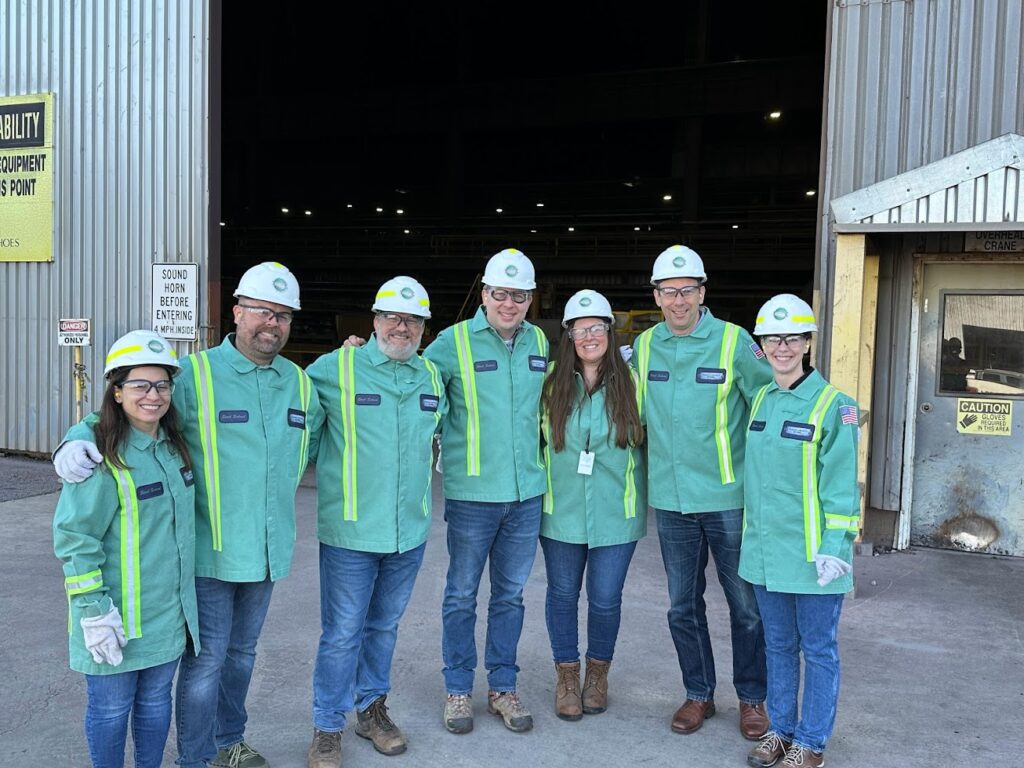Tour of Nucor-Yamato Steel Mill
Cora Structural was a special guest of the American Institute of Steel Construction’s (AISC) Sustainability Committee to participate in a behind the scenes tour of the Nucor-Yamato steel mill in Blytheville, AR. The mill produces millions of tons of rolled steel sections each year.
At the tour were representatives from the steel industry across the country including fabricators, service distribution centers, and suppliers as well as architects, engineers, contractors, and owners. The day was broken into two parts: 1. walking the steel mill and observing the process of creating steel sections starting with the initial loading of scrap steel to the electric arc furnace and continuing through to the finish rolling of wide flange sections and 2. an in depth discussion on the future of sustainable steel production which followed presentations by Nucor-Yamato, AISC, and other steel professionals.
The mill facility and its multiple buildings, roads and yards couldn’t have been any more impressive. It was incredible to watch with one’s own eyes the well-choreographed process of taking large amounts of scrap steel and converting it to new molten steel and casting large ‘blanks’ for eventual rolling to a finished product. On any given day there are specific sets of wide flange sections produced by first re-heating the blanks and then running through rollers to get the specified sizes. Standing in the facility it was hard not to ‘nerd out’ a bit and feel the awesome capacity of steel.
It’s one thing to talk about the benefits of an Electric Arc Furnace (EAF) over that of a Basic Oxygen Furnace (BOF) for steel production but its a whole other thing to stand next to one and hear the sound of (and feel the vibration of) the electric current arcing across electrodes and melting recycled scrap steel.
Michael Gyniuk, Principal, Cora Structural
At each stage of the production process were stations of employees of the mill working to ensure all systems were functioning appropriately and the highest levels of quality control. The employees were very generous with their time to explain the process and answer all of our questions.
We appreciated the candid discussion about how to achieve more sustainable steel. We reviewed the complexities of the global supply chain, the amount of scrap steel available, and how much the mill can produce in a given year (it’s a lot!). The representatives at the mill were very willing to answer all of our questions and even had some for us.
In our humble opinion, being in facilities producing the structural elements we design and specify daily provides an invaluable perspective that ultimately makes us better structural engineers. We are so thankful to Nucor-Yamato Steel, AISC, and others for the opportunity and for taking the time to show us around and answer all of our (many, many) questions.
We learned SO much and looking forward to bringing our knowledge to future projects.
Do you know the impact of your project’s steel?
On a recent project we reviewed the source of steel for a large frame located in Boston, MA. On that project, for a large educational institution, the steel mill certificates were collected and the mill source of each member was determined. For that project and tonnage, about 800 tons, 65% of the steel was domestically sourced whereas the other 35% was from overseas mills. Using the facility-specific Environmental Product Declarations (EPD) we found that the embodied carbon impact of the domestic steel was significantly less than that of the overseas steel per ton, even to the point where the impact of the overseas steel was nearly the same as the domestic steel even at half the tonnage. There are several reasons for this and we’d be happy to discuss them with you. Have you checked your steel?
Here are some useful links to industry average EPDs and specification guidance. Note that the link to industry average EPDs also has links to facility-specific EPDs for domestic steel.
Steel Environmental Product Declarations (EPDs) from AISC – Industry Average EPDs
Specification Guidance from SE 2050 – Steel Spec Guidance
Reach out if you have questions or want to learn more!

